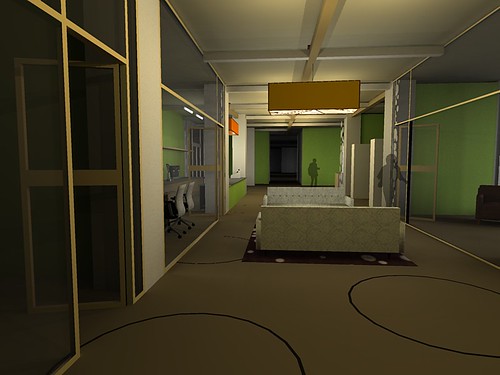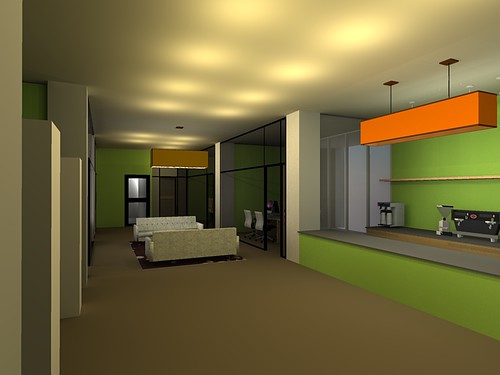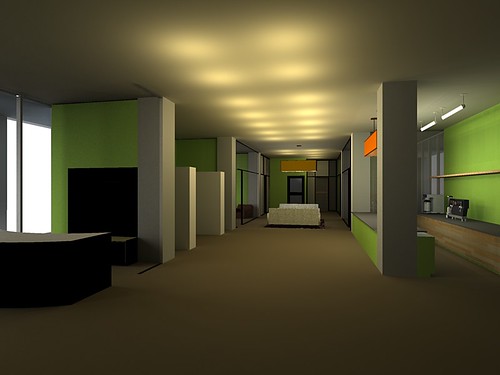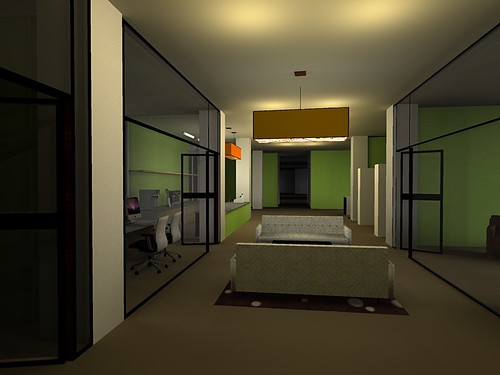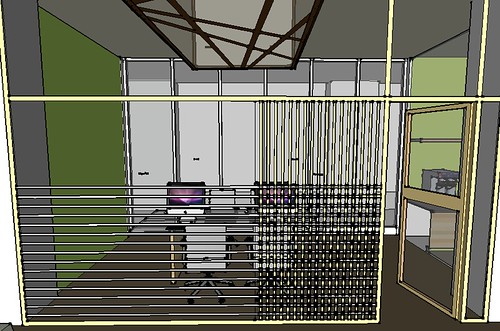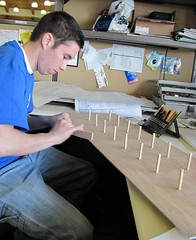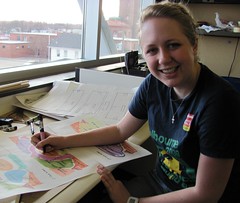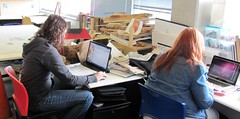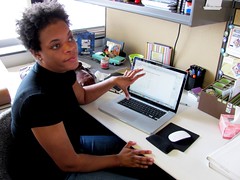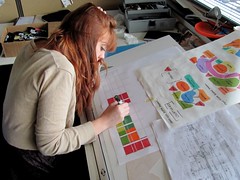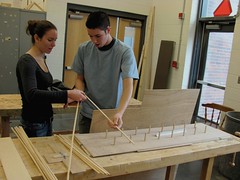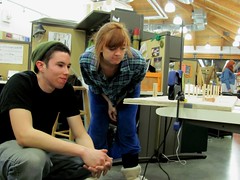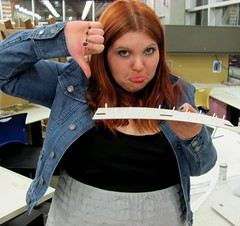2 months ago
Wednesday, May 26, 2010
CAD in Interior Architecture
Computer Aided Design (CAD) has come a long way since its initial conception. Dreams of what it could be have failed and in other aspects, it has surpassed any and all inital expectations. CAD has become an integral part of how architects and interior architects design the buildings and spaces we inhabit. In the modern world, it seems impossible to imagine designing a building or space without the help of computers. These programs may calcuate sunlight, flow and other attributes. But they also serve as a medium to design within, allowing unthought-of shapes and forms. They allow the automation of certain tasks, taking away what may be munadane and boring work. Computer cannot, however, replace the designer. The human element of design is what makes it what it is- computers are not able to realize human needs on the same level that a person can.
Wednesday, April 28, 2010
happy design & unhappy design
There are a lot of places and spaces that make me happy- which isn't to say I can't find some serious flaws with them. One of these places is the Anthropologie at Rockefeller Center in New York City. Now, of course, this may be because I debatably have a shopping addiction and I'm a fan of pretty much everything Anthropologie does in their stores and sells, but this space is pretty amazing. The store is huge and yet is divided up so that it feels somewhat homey- even despite the tourist-y bustle of Rockefeller Center just outside. I would literally just go in here and chill out because it felt good- and then walk out with a $160 jacket (it was on sale from $300!).


Now, what makes me unhappy. Well, a lot of things make me unhappy. A lot of spaces make me unhappy. And anyone who goes anywhere with me knows that the first thing I'll see when I walk in somewhere, no matter how beautiful it is, is what is wrong. (This doesn't mean I don't appreciate what is right). However, I think that if I could re-do anything, it would be somewhere that I come in contact with daily. This would be the kitchen in my apartment. It's very small, which isn't the real issue with it. The main problem is that whoever "designed" this kitchen didn't take advantage of what space is there. There is barely any counter room, appliances are awkwardly place, and some cabinets are downright difficult to get into. Not to mention, when designing a kitchen, please, I beg you, always put a place for a trash can. I would say to even put "trashcan" in the programming. In basically every kitchen I have ever been in, there's no good place to put the trashcan except under the sink or in a cabinet of it's own, which is nice, but often a tad bit too small. I basically never cook in my kitchen, not only because I don't like to cook (nor am I good at it, nor do I ever want to do dishes), but because this kitchen is so non conducive to cooking.


Now, what makes me unhappy. Well, a lot of things make me unhappy. A lot of spaces make me unhappy. And anyone who goes anywhere with me knows that the first thing I'll see when I walk in somewhere, no matter how beautiful it is, is what is wrong. (This doesn't mean I don't appreciate what is right). However, I think that if I could re-do anything, it would be somewhere that I come in contact with daily. This would be the kitchen in my apartment. It's very small, which isn't the real issue with it. The main problem is that whoever "designed" this kitchen didn't take advantage of what space is there. There is barely any counter room, appliances are awkwardly place, and some cabinets are downright difficult to get into. Not to mention, when designing a kitchen, please, I beg you, always put a place for a trash can. I would say to even put "trashcan" in the programming. In basically every kitchen I have ever been in, there's no good place to put the trashcan except under the sink or in a cabinet of it's own, which is nice, but often a tad bit too small. I basically never cook in my kitchen, not only because I don't like to cook (nor am I good at it, nor do I ever want to do dishes), but because this kitchen is so non conducive to cooking.
Wednesday, April 14, 2010
A Classmate's Design Strength
I talked to Haley Preston about her design strengths. She is a very organization-oriented person, and uses this to her advantage when designing spaces. She feels that her greatest strengths lie in laying out spaces- from the level of dividing it into rooms down to the furniture. She feels that she has a good eye for what works and what doesn't, what is appealing to the eye and what just doesn't work. She feels she is also strong when it comes to the more technical aspects of what works and what doesn't- for example where you can't put an oven or a door.
Monday, April 12, 2010
Unity Village: Phase 3: Modeling
Two bedrooms in around 900 square feet isn't easy. I live in a one bedroom apartment that is 900 square feet and I often wish it was a tad bit bigger! The space becomes even more tight when trying to allow someone in a wheelchair to have adequate room to maneuver easily. After playing around with fun curved walls and knowing where rooms and spaces should lie (for example, I really wanted both bedrooms to have equally easy access to the bathroom), I came up with this floor plan.

I then set about creating three models to get out some more ideas. The concept for the space has to be carried over from the previous phase of the project- Chaos and Order. I have decided that the chaos needs to happen on the ceiling, since chaos on the floor probably isn't the best thing for someone in a wheelchair- or even someone walking! The pieces of wood hanging down are an idea to create something chaotic, engage the ceiling, and define the living space from the kitchen/dining space.
thinking about book display in the living room
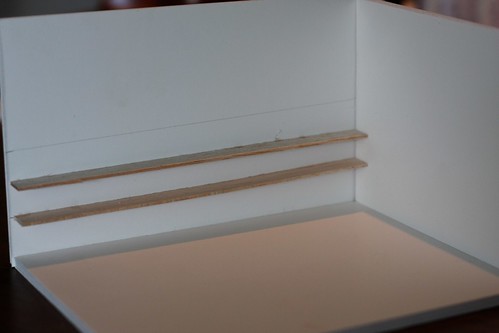
all books would be easily accessible by the resident.
the kitchen area
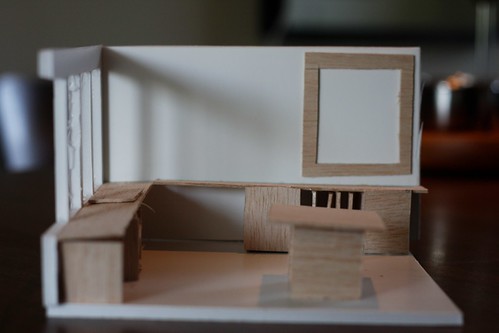
i want to leave most of the space under the counters open so that the resident can easily wheel under the counters. he eats out most of the time, so a lot of storage space isn't needed.

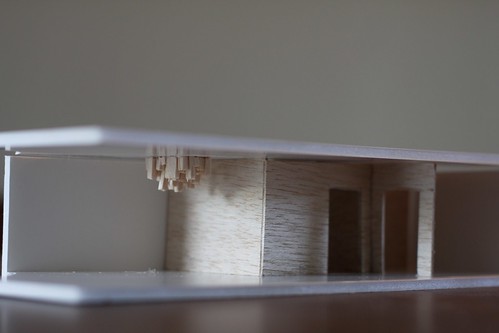
in this image you can see one way i have thought about engaging the ceiling.



I then set about creating three models to get out some more ideas. The concept for the space has to be carried over from the previous phase of the project- Chaos and Order. I have decided that the chaos needs to happen on the ceiling, since chaos on the floor probably isn't the best thing for someone in a wheelchair- or even someone walking! The pieces of wood hanging down are an idea to create something chaotic, engage the ceiling, and define the living space from the kitchen/dining space.
thinking about book display in the living room

all books would be easily accessible by the resident.
the kitchen area

i want to leave most of the space under the counters open so that the resident can easily wheel under the counters. he eats out most of the time, so a lot of storage space isn't needed.


in this image you can see one way i have thought about engaging the ceiling.


Sunday, April 11, 2010
What Makes Me A Good Designer
When I start designing a space, I never stop thinking about it. From the moment I get the assignment, I start observing everything around me and seeing how it might fit into the assignment I'm currently working on. This could be spaces I walk into or images I come across online or pictures in a magazine. Through these observations I may find out something that makes a space more user-friendly at a product level or I might get inspired in a more abstract way for what the space might look like.
I am also always using experiences I have had as inspiration, especially from my travels. Most people who know me know that I am always planning a trip to somewhere or am talking about somewhere I have been. Throughout the world, the country, the region, and the city, there are so many things to learn and be inspired by.
I am also always using experiences I have had as inspiration, especially from my travels. Most people who know me know that I am always planning a trip to somewhere or am talking about somewhere I have been. Throughout the world, the country, the region, and the city, there are so many things to learn and be inspired by.
Friday, April 2, 2010
Unity Village: Assessments
Neighborhood A
Ground Floor
This group’s design for the ground floor of Unity Village utilized strong linear geometric forms, bright and crisp colors, and unexpected use of materials to define space and add interest to the floor with the least natural light and space. Their program called for the daycare, grocery and laundry to be the main areas of this floor. Their design was very open, inviting, and invigorating due to the use of color. The bright white used on the walls not only provided a blank canvas as they said, but also added a lot of light to the space. Their interesting lighting, which at points travelled down walls, was good creative risk and worked well, creating the illusion of light pouring in through a window as well as adding the unexpected. The use of the same wood flooring on the floor and ceiling created a streamlined effect and added warmth to the space, as well as grounded it (no pun intended). I feel that the space is conducive to community, but the elderly might not find it as visually appealing as the other user groups.

First Floor
The concept of conversation utilized by this group strongly tied to community, and it shows. From this concept they achieved an inviting, fluid space. Their strongest achievement I felt was the entryway with the logo- something no other group thought about. The circles from the simple yet strong logo were utilized throughout the rest of the space. The layout and use of materials encourages movement but is punctuated with stopping places- not unlike a breath one might take while in conversation.
Second Floor
This design for the second floor incorporated a worship area, medical clinic, gym with locker room, and a library with a conference room and children’s area. While each amazing space stood out on its own, they were not cohesive as a whole. I thought that incorporating a worship/meditation area into the program was an excellent idea. It creates a place within the building to get away. Having a medical clinic means that a person could go extended periods of time without leaving the building- a very good thing if a person is sick or injured. As a severely accident-prone person, I appreciate the fact that it is on the same floor as the gym (just ask me about the time I was attacked by an exercise bicycle...). Having a library adds an intellectual touch to the building. I did not think of it at the time, but I wonder how many books the library is designed to hold and what types of books will it hold?

My Team
Hailey Allen and I created a design for the first floor of Unity Village, as can be seen in previous posts. After seeing what Neighborhood A did with the entry area, I wished we had addressed that area better. Now it seems so obvious that it deserves extra attention since it can be seen clearly from the outside before someone even enters the building. Other than this, I feel that we achieved a strong space and a place that people would want to be in.
Our biggest struggle in the process was concept. In the past, we had been honing a concept down to a single abstract word or idea that was to guide us throughout the process. Now we were asked to expand what a concept is. Though I believe that a more expanded concept makes a lot more sense, it was hard to break the confusing-one-word concept definition. However, we eventually (and thankfully) (and rejoicefully) had an aha! moment. The rest of our process, both in designing as well as portrayal through digital rendering and the physical model, went extremely smoothly.
I feel that we used “design thinking” in our process. We were concerned with the residents of the building as a community and what their experiences might be like. I often think of this building also as a neighborhood within itself. It has the neighborhood coffee shop, the neighborhood post office, the daycare, etc. The physical things one would find within a physical neighborhood. By creating this sub-neighborhood within the greater neighborhood outside the building, I feel that community is fostered among the residents. The places in a neighborhood give people a chance to interact, see the same people again and again, and thus make connections between one another. With these connections come tolerance and understanding between the diverse residents of this building. It is working as a system, and “design thinking” is about systems, especially community systems.
Ground Floor
This group’s design for the ground floor of Unity Village utilized strong linear geometric forms, bright and crisp colors, and unexpected use of materials to define space and add interest to the floor with the least natural light and space. Their program called for the daycare, grocery and laundry to be the main areas of this floor. Their design was very open, inviting, and invigorating due to the use of color. The bright white used on the walls not only provided a blank canvas as they said, but also added a lot of light to the space. Their interesting lighting, which at points travelled down walls, was good creative risk and worked well, creating the illusion of light pouring in through a window as well as adding the unexpected. The use of the same wood flooring on the floor and ceiling created a streamlined effect and added warmth to the space, as well as grounded it (no pun intended). I feel that the space is conducive to community, but the elderly might not find it as visually appealing as the other user groups.

First Floor
The concept of conversation utilized by this group strongly tied to community, and it shows. From this concept they achieved an inviting, fluid space. Their strongest achievement I felt was the entryway with the logo- something no other group thought about. The circles from the simple yet strong logo were utilized throughout the rest of the space. The layout and use of materials encourages movement but is punctuated with stopping places- not unlike a breath one might take while in conversation.
Second Floor
This design for the second floor incorporated a worship area, medical clinic, gym with locker room, and a library with a conference room and children’s area. While each amazing space stood out on its own, they were not cohesive as a whole. I thought that incorporating a worship/meditation area into the program was an excellent idea. It creates a place within the building to get away. Having a medical clinic means that a person could go extended periods of time without leaving the building- a very good thing if a person is sick or injured. As a severely accident-prone person, I appreciate the fact that it is on the same floor as the gym (just ask me about the time I was attacked by an exercise bicycle...). Having a library adds an intellectual touch to the building. I did not think of it at the time, but I wonder how many books the library is designed to hold and what types of books will it hold?

My Team
Hailey Allen and I created a design for the first floor of Unity Village, as can be seen in previous posts. After seeing what Neighborhood A did with the entry area, I wished we had addressed that area better. Now it seems so obvious that it deserves extra attention since it can be seen clearly from the outside before someone even enters the building. Other than this, I feel that we achieved a strong space and a place that people would want to be in.
Our biggest struggle in the process was concept. In the past, we had been honing a concept down to a single abstract word or idea that was to guide us throughout the process. Now we were asked to expand what a concept is. Though I believe that a more expanded concept makes a lot more sense, it was hard to break the confusing-one-word concept definition. However, we eventually (and thankfully) (and rejoicefully) had an aha! moment. The rest of our process, both in designing as well as portrayal through digital rendering and the physical model, went extremely smoothly.
I feel that we used “design thinking” in our process. We were concerned with the residents of the building as a community and what their experiences might be like. I often think of this building also as a neighborhood within itself. It has the neighborhood coffee shop, the neighborhood post office, the daycare, etc. The physical things one would find within a physical neighborhood. By creating this sub-neighborhood within the greater neighborhood outside the building, I feel that community is fostered among the residents. The places in a neighborhood give people a chance to interact, see the same people again and again, and thus make connections between one another. With these connections come tolerance and understanding between the diverse residents of this building. It is working as a system, and “design thinking” is about systems, especially community systems.
Thursday, April 1, 2010
Unity Village: First Floor: Process Podium Renderings
Monday, March 29, 2010
Unity Village: 3 Experiences
Ralph, a 72 year old man who uses a wheelchair, exits the elevator onto the first floor. He has come here to have his morning coffee along with many of his friends from the building. They often sit around the tables for hours, watching people come and go, going on about their busy lives. He is glad his life is no longer so hectic, and he and his friends talk about the days when they were rushing off to work, their days in college, and when they were kids and when their children were smaller. It is a nice spring day to go outside, and he is able to do so with the push of a button to open the door. He finds living within Unity Village to be fulfilling.
Zoe, a 6 year old girl, is sleepily dragged off of the elevator by her mother. Zoe isn’t a morning person. Her mother, about to go off to work, takes Zoe to the daycare, where she is greeted by other sleepy 6 year olds, none of them morning people. She hands her lunchbox to Courtney, her favorite daycare monitor, so that it can be stored away for later. Suddenly having a burst of energy- which may have something to do with the presence of her friends, the bright sunlight pouring in, or the bright, cheerful colors surrounding her (or maybe a combination of all of the above), she runs off to play, climbing the ladder, sliding down the indoor slide at the bottom of which she is greeted by a seven year old boy with a ball. Before she knows it, it’s the end of the day and her mother is back and she doesn’t want to leave.
Catherine, a 42 year old mother who works in the building’s small grocery store, has come downstairs to enjoy a cup of tea and look at the new collection of art she has heard is currently being displayed. She goes to the coffee bar and orders a cup of water and an Earl Grey teabag. She walks over to the art gallery area. The current exhibit is a collection of paintings done by college art students of the building working with children in the building. Catherine finds the one her son did with Manuel, one of the college students. She is pleasantly surprised at her son’s talent. One of her friends sees her and comes over, bragging on her own child’s work. They decide to sit outside and spend much of the afternoon talking while more of their friends in the building come and go.
Zoe, a 6 year old girl, is sleepily dragged off of the elevator by her mother. Zoe isn’t a morning person. Her mother, about to go off to work, takes Zoe to the daycare, where she is greeted by other sleepy 6 year olds, none of them morning people. She hands her lunchbox to Courtney, her favorite daycare monitor, so that it can be stored away for later. Suddenly having a burst of energy- which may have something to do with the presence of her friends, the bright sunlight pouring in, or the bright, cheerful colors surrounding her (or maybe a combination of all of the above), she runs off to play, climbing the ladder, sliding down the indoor slide at the bottom of which she is greeted by a seven year old boy with a ball. Before she knows it, it’s the end of the day and her mother is back and she doesn’t want to leave.
Catherine, a 42 year old mother who works in the building’s small grocery store, has come downstairs to enjoy a cup of tea and look at the new collection of art she has heard is currently being displayed. She goes to the coffee bar and orders a cup of water and an Earl Grey teabag. She walks over to the art gallery area. The current exhibit is a collection of paintings done by college art students of the building working with children in the building. Catherine finds the one her son did with Manuel, one of the college students. She is pleasantly surprised at her son’s talent. One of her friends sees her and comes over, bragging on her own child’s work. They decide to sit outside and spend much of the afternoon talking while more of their friends in the building come and go.
Friday, March 19, 2010
design thinking
Design thinking is about getting away from “small” design and moving toward community-oriented “big” design. “Small” design is fashionable products that are interesting and perhaps desirable, whereas “big” design encompasses a system.
The Unity Village project is all about design thinking. It is a community project, therefore, it seems only appropriate that the community would be involved in the design. This is being accomplished through in-depth research about the user groups. Within each design decision, each user group is considered. Each space, floor, and the building as a whole is thought about as being a system- in this case, a community.
Design thinking will inform my decisions in the future as well. I have realized how important it is to not sit in a room as a designer and design a room for a consumer, but to instead involve the end user(s) in the process if at all possible. This aids in asking the right questions and finding the right answers. The people in the situation naturally have a good idea of what works or what is missing in a space. Their questions lead to bigger questions that need to be answered by the designer.
The Unity Village project is all about design thinking. It is a community project, therefore, it seems only appropriate that the community would be involved in the design. This is being accomplished through in-depth research about the user groups. Within each design decision, each user group is considered. Each space, floor, and the building as a whole is thought about as being a system- in this case, a community.
Design thinking will inform my decisions in the future as well. I have realized how important it is to not sit in a room as a designer and design a room for a consumer, but to instead involve the end user(s) in the process if at all possible. This aids in asking the right questions and finding the right answers. The people in the situation naturally have a good idea of what works or what is missing in a space. Their questions lead to bigger questions that need to be answered by the designer.
Labels:
consider:process:design,
solo reflections
Unity Village: First Floor: Process 1
Concept Statement:
The first floor of Unity Village will contain the lobby area, mail boxes, management offices, conference rooms, daycares, and coffee shop. These spaces will be the first thing residents, guests, and staff see inside the building and the last experience before leaving. Therefore, the spaces within this floor will be lively and inviting. This will be accomplished through warm colors, soft textures, and twinkling lighting.
A rough sketch of the floor plan for the first floor of Unity Village

A page of sketches when thinking about the first floor of Unity Village.

Some information from Timesaver Standards we found to be pertinent. There is also a wealth of other information within this book that we will continue to refer to throughout our process but did not feel these pages were necessary to scan as of this time.
Chiara, Joseph, Julius Panero, and Martin Zelnik. Time-saver standards for interior design and space planning. McGraw-Hill Professional, 2001. Print.




The first floor of Unity Village will contain the lobby area, mail boxes, management offices, conference rooms, daycares, and coffee shop. These spaces will be the first thing residents, guests, and staff see inside the building and the last experience before leaving. Therefore, the spaces within this floor will be lively and inviting. This will be accomplished through warm colors, soft textures, and twinkling lighting.
A rough sketch of the floor plan for the first floor of Unity Village

A page of sketches when thinking about the first floor of Unity Village.

Some information from Timesaver Standards we found to be pertinent. There is also a wealth of other information within this book that we will continue to refer to throughout our process but did not feel these pages were necessary to scan as of this time.
Chiara, Joseph, Julius Panero, and Martin Zelnik. Time-saver standards for interior design and space planning. McGraw-Hill Professional, 2001. Print.




IDEATION
......this project is all about...
......truly significant aspects of the site include...
......unique aspects of this project include...
......the functional requirements obviously point to an organizational pattern that...
...a few adjectives that fit this project are...
...conceive workable approaches
...externalize the approaches
...consolidate ideas and choose a direction.
-There is a myth that concepts have to be unique and different.
-Ideas usually arise as thoughts, mental pictures, or diagrams or drawings while you sketch. It is important to capture ideas when they arise, even before judging them.
-Two ways to externalize concept approaches are visual and verbal.
Rengel, Roberto. Shaping Interior Space. second. New York: Fairchild Books, 2007. 138-71. Print.
......truly significant aspects of the site include...
......unique aspects of this project include...
......the functional requirements obviously point to an organizational pattern that...
...a few adjectives that fit this project are...
...conceive workable approaches
...externalize the approaches
...consolidate ideas and choose a direction.
-There is a myth that concepts have to be unique and different.
-Ideas usually arise as thoughts, mental pictures, or diagrams or drawings while you sketch. It is important to capture ideas when they arise, even before judging them.
-Two ways to externalize concept approaches are visual and verbal.
Rengel, Roberto. Shaping Interior Space. second. New York: Fairchild Books, 2007. 138-71. Print.
Wednesday, March 3, 2010
Monday, March 1, 2010
Wednesday, February 17, 2010
Fostering Community: My Sister's House

My Sister's House, completed by Interior Architecture students, will serve as a home and place of refuge for young mothers. In an instance such as this, the idea of community is very important. Community will make the difference between this place being just somewhere to stay and it being a home, where laughter, tears, and advice is shared.
The structure provides many instances in which interactions among inhabitants can happen. The greatest instance of this is the community kitchen, which each person will use. It is large and rather spacious, meaning there will be enough room for a few people at the same time. Kitchens have long been places of community within homes and other dwellings. People come together over food perhaps more than anything else.
Friday, February 12, 2010
Makeshift Shelter : Process

The first major project assigned in studio this semester was to built a makeshift shelter of found materials. This required us to go out and find materials, sketch and write about our ideas, and finally to put our materials and ideas together to create a shelter. Each group was given a individual activity that most of us do every day. The group I was assigned to was to build our shelter on the idea of snacking.
Upon receiving the assignment, we were excited and overwhelmed. Each of us had so many great ideas, and yet we had no idea where to start. The most logical place for me to start is sketching. Along with sketching, I write. The writing helps to clarify anything that may not be able to be conveyed in drawing. It is once I start writing about my ideas that I begin to realize what works and what does not- what is feasible and what is absurd. Writing helps me to think things out- it slows down my thoughts so that I am more methodical. When I reach something that I cannot find words for, I draw. Even small sketches and a few short words help to organize an idea greatly.
These sketches and words come together in my sketchbook along with inspiring images pulled from websites and magazines. Sometimes these images are an example of what I would like to happen in a space, and sometimes I just like the vibe of the image and so I include it. One of the inspiration images I used is of a wall made of water bottles. I had come up with the idea to use water bottles after having seen them somewhere else. Finding the image and putting it in my sketchbook helped convey the idea to the other members of my group. I felt that the contribution of this idea was important- as it was tightly linked to the idea of snacking.
I believe that within our group our roles were very much equal. Each of us worked on each aspect of the project. On the first evening, Carlos Smith and I went out to find materials, while Veronica Harvey and Haley Preston gathered water bottles. We collectively designed and built the structure as well as contributed drawings and images. While I usually find that within groups it is best to allocate different jobs to different individuals, this arrangement worked very well for this particular group on this particular project. I do not think it could have gone smoother any other way.
I was very pleased with the outcome of this project, both for my group’s shelter and those of other groups. I only wish that on our shelter the water bottles could have been used as we had intended, which would have involved having many more of them. We collectively made the decision after talking with Stephanie that it would be best if the plastic bottles could be recycled after use, especially since we got many of them from recycling. This meant that they could not be glued together. Cutting the bottles and sliding them together proved more difficult, time consuming, and unsteady than we had imagined, resulting in us deciding to use the water bottles in a different way than originally intended. I still believe that they had a very interesting impact on the shelter.
During this project I felt that I was very strong in seeing the potential in found objects. I used my strength and love of photography to document as much of the process as I could and these images can be found on my blog. I also was able to use my strength of figuring out the best way to assemble things, which helped in the building of the shelter.
I will remember this project as being very fun to do and also as a good design exercise. We so often forget to work with what is available to us and instead opt for new things. In trying to design a sustainable environment, however, the most “green” things are those that have been repurposed (instead of being disposed of- not something new). Also, repurposed materials add distinct, unique character. The limitations on the number of materials helped us all to realize that “less is more.” Before the limitation was given to us, our ideas and thoughts were scattered, but upon receiving the limitation, we found it much easier to organize our thoughts and know what to do. Therefore, the limitation was not a limitation at all, but rather an aid- which is perhaps the most important thing to learn and remember.
Sunday, February 7, 2010
Neighborhoods&Communities
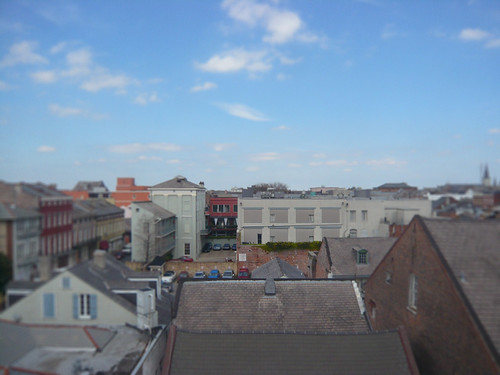
Communities and neighborhoods go hand-in-hand. A neighborhood is typically geographically defined. A community is the people brought together not only geographically but by common ties. Within a neighborhood, there are often regulations that promote uniformity and cleanliness. Some neighborhoods are loosely formed, while other are "gated communities." Affluent neighborhoods tend to have better schools, resources, and safer environments than less affluent neighborhoods.
People often measure their self worth on that of others in their neighborhood- though they may not necessarily have community ties to them other than living within the same vicinity. If most residents exhibit a certain behavior, then members of that community- especially children growing up within the community- are likely to exhibit the same behavior. When people are proud of their neighborhood, they take care of it.
The boundaries and contents of neighborhoods are often changing due to zoning. Zoning prevents anything from being built just anywhere. While the community may not necessarily have a say in what is allowed and what is not, meetings of community members are often held to discuss these matters. Residents should have a say in what is built within their neighborhood.
PUD housing schemes are very popular in today's society. They allow more house for less money. These houses are often built very close together to cut down on supplies and maximize the economical return to the owner of the land. These are the houses we see built so quickly and cheaply, all with the same vinyl-siding clad homogenous look. Studies have shown that many owners of these cookie cutter homes are not fully happy with them, however they seemed the greatest value because the houses have more square feet for less money. Our society promotes conformity- thus home owners associations exist. While these associations may keep neighborhoods looking nice and neat, they may hinder creativity and expression through the appearance of one's home. There have been movements to create sustainable communities- in which the homes may be built of more sustainable materials and a portion of the land is dedicated to farming and/or left in its natural state.
Labels:
consider:process:design,
solo reflections
Thursday, February 4, 2010
Fostering CommUNITY
CommUnity
View more presentations from cgust.
Izola, Slovenia
2006
Ofis Arhitekti



• Located on the coast of Izola, Slovenia. This seaside structure appeals to young, small families and couples.
• There was increased need for small, affordable housing for these young families.
• Constructed for low-income residency.
• The concept of a rhythmic beehive was an attempt to foster community by paralleling the drive of worker bees in the hive, but was unsuccessful.
• The Honeycomb Housing Complex brings together people of similar backgrounds, and social and economic standing in one building, but gives them no reason to interact or form a community.
• The staggered elevations of the balconies is successful for creating private space between neighbors.
• By end of 1980s housing inefficient
• Home ownership based on favorable credit
• Home ownership in urban areas were not affordable, over priced for most people
• Rental units affordable, but scarce
• cost to construct & maintenance was higher than the rental cost
• housing shortages underestimated
Copenhagen, Denmark
2004
Bjarke Ingels Group




• Scandinavian architecture has been one that increases its program for years. The architects continually try to combine many public places into one functional whole.
• This architecture focuses on form and functionality, and inspiration.
• The Maritime Youth House was a special challenge because it was essential that the space focused on two clients: a sailing club and a Children’s center.
• Some important programming issues were giving the children enough safe space to play and also allowing mooring space for the boats.
• Another issue was the site. The site of the construction was riddled with polluted topsoil, which the architects ingeniously decided to build over.
• The architects decided to build a large, elevated wooden deck over the contaminated land, allowing a sprawling space for the children to play and openings underneath for the boats to moor.
• The gently sloping deck fosters community by allowing a great space for the children and center supervisors to interact.
• Indirectly, the space allows sailing club members to interact with the Youth House as well by keeping them connected.
• The fascinating deck serves as the focal point of the project. It is unexpected, inviting, and draws many people to come enjoy the space together.
Mandic, S., & Rop, T. New housing challenges in Slovenia
Cities, Volume 10, Issue 3, August 1993, Pages 237-245
http://libproxy.uncg.edu:2100/science?_ob=ArticleListURL&_method=list&_ArticleListID=1194305163&_sort=d&_st=1&_acct=C000033084&_version=1&_urlVersion=0&_userid=628623&md5=1d564b65dd568f26608ac2f6a34e08ee
Paulsson, Thoman. Scandinavian Architecture. 1st. Bristol, England: Western Printing Services Ltd., 1959. 239-244. Print.
Lobodzinska, Barbara. Family, Women, and Employment In Central-Eastern Europe. 1st. Westport, CT: Greenwood Press, 1995. 230-231. Print.
Subscribe to:
Posts (Atom)

